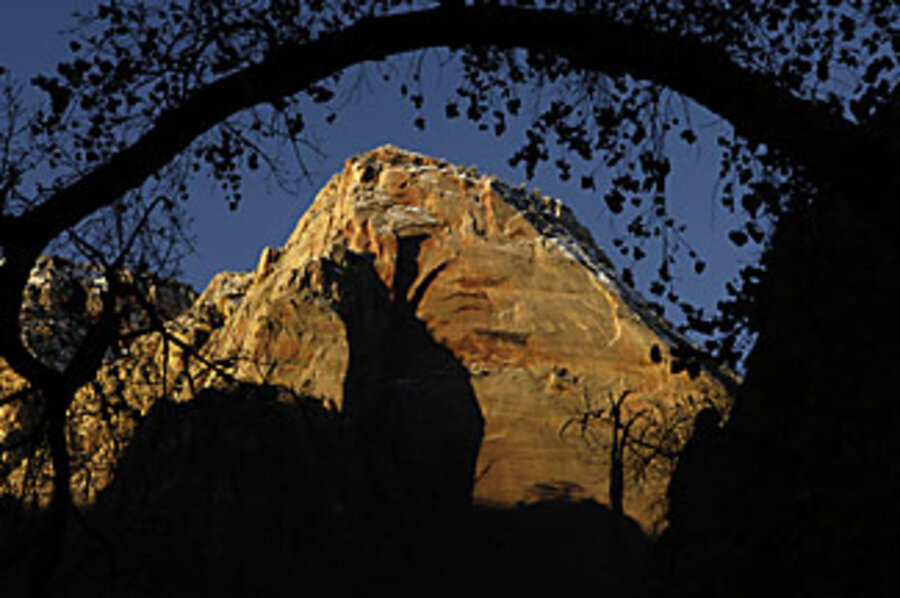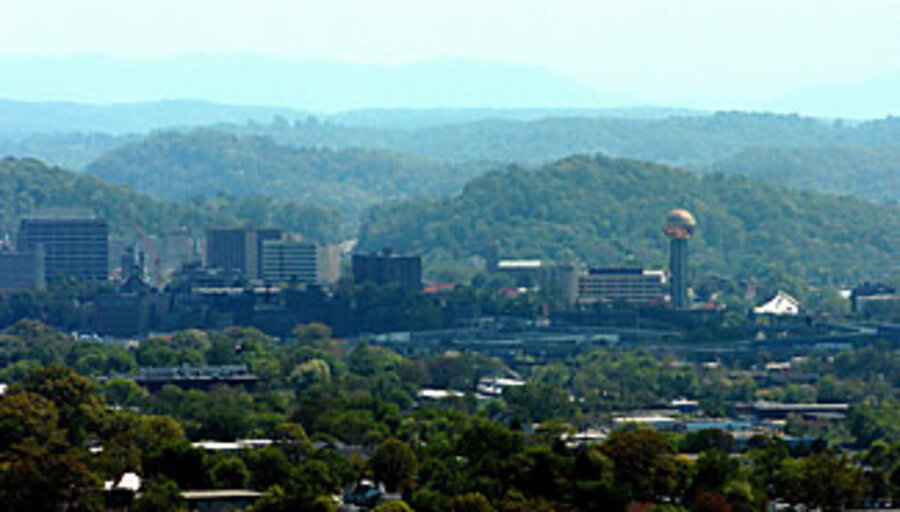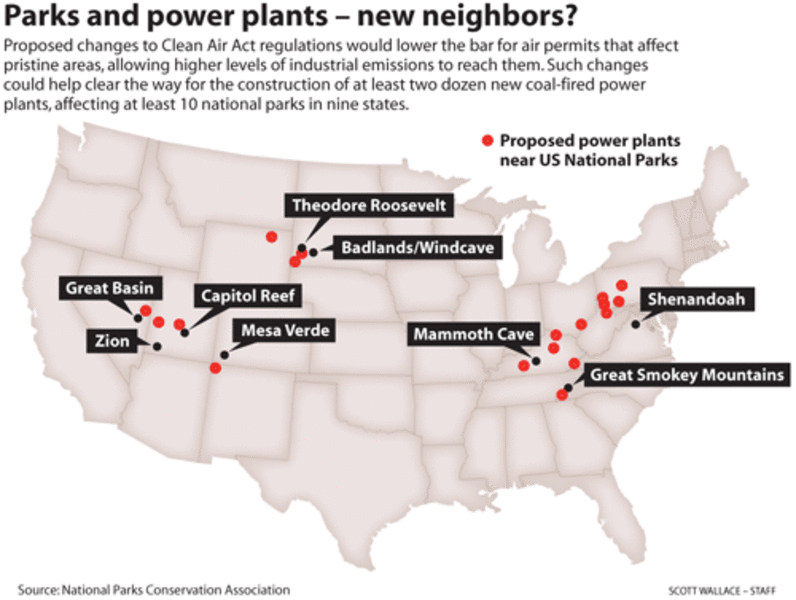Why national parks, coal-fired power plants may be neighbors
Loading...
Nature photographer Hullihen Moore specializes in vistas of Virginia's Shenandoah National Park, but worries he'll soon be unable to see his beloved ridgelines through a yellowish haze of industrial emissions.
On some days, thick air already obscures mountains just a few miles distant, he says. So adding six new coal-fired power plants nearby, as is proposed, might make view-gazing impossible.
Shenandoah isn't the only national treasure whose scenic values are up in the air, however. From Virginia to Utah, the air quality of at least 10 national parks, including many with crystalline views, is threatened by plans to build at least two dozen new coal-fired power plants, parks advocates and air-quality experts say.
The little-known reason places with names like Badlands, Wind Cave, and Great Basin could soon see sullied air is a federal proposal that would lower the bar for developers seeking permits to build upwind of the parks, these critics say.
Despite blunt internal criticism by its own staff experts, the Environmental Protection Agency (EPA) is proceeding with a plan by year's end to revise regulations under the Clean Air Act that currently safeguard areas with some of the nation's cleanest air.
Across the United States, 156 national parks, wilderness areas, and wildlife refuges have been designated by Congress as Class-1 areas, granting them the toughest legal protection.
Officially, the EPA says it is proposing "refinements" to regulations that measure Class-1 air-quality standards.
But federal air-quality experts at the EPA and the National Park Service say the planned changes would be a backward step for air quality.
"It's hard to see this proposal as improving air quality in the parks," says John Bunyak, policy chief at the National Park Service's planning and permit branch, which oversees air-quality issues. "It could allow additional pollution sources to locate in a particular area, where they wouldn't have been permitted under the old rule."
Inside the EPA, staff air experts have protested that the proposal would weaken the criteria used to evaluate just how polluted a Class 1 area already is – and how much pollution a new industrial facility would be permitted to add to that area.
EPA regional staff experts, in internal documents, said the proposal provided "the lowest possible degree of protection" against spikes in pollution – a common occurrence during hot days, when power plants operate at near maximum output.
The proposed changes would effectively hide pollution spikes from regulators, ignore existing major polluters, allow "phony pollution accounting" methods, and let states establish their own standards, says Mark Wenzler, clean air director of the National Parks Conservation Association, a Washington-based advocacy group.
An EPA spokesman in Washington declined to grant an interview or respond to e-mailed questions. A fact sheet about the proposed rule and a letter to Congress on the change were referred instead. "The proposed rules would provide greater regulatory certainty and reduce complexity without sacrificing the current level of environmental protection," the fact sheet says.
Controversial changes
Central to the proposal, say Park Service and EPA experts, are four changes. They would:
•Substitute an annual average of emissions for the current "maximum" emissions that is measured over a few hours, up to a single day.
•Exclude from pollution estimates output from existing industrial emitters that have been granted variances.
•Switch from calculating emissions using the two most recent years of data to any time period "more representative" of normal operations.
•Grant discretion to state regulators to use whatever data and information in their judgment would be most reliable in calculating emissions.
The final period of public-comment on these changes closed earlier this month. The final rule is expected to take effect before the end of the year.
Several federal air-quality experts contacted by the Monitor say it is clear to them that EPA's planned changes would weaken the underpinnings of clean-air standards for Class 1 regions.
"We're talking about more pollution in national parks and wilderness, not less, because of this proposed change," says a federal air-quality expert, who asked not to be named because he was not permitted to speak to the press.
Lawmakers raise objections
Congress is concerned, too. In February, Rep. Henry Waxman (D) of Calif., chairman of the House Committee on Oversight and Government Reform, sent a letter expressing his concerns to EPA Administrator Stephen Johnson. In it, Congressman Waxman quotes an internal e-mail from Mr. Bunyak that compares the EPA's plan to average polluters' emissions over a year when evaluating air permit applications to "allowing a person to average all the variations in his driving speed over [an] entire year to see whether he is complying with the 55-mile-per-hour speed limit."
"It looks like the EPA is once again ignoring the law and the best guidance of their career staff and operating instead from a political perspective," Waxman said in an interview. "We've seen it from the documents we already have and it's a troubling story."
Officials at EPA, however, broadly rebuffed Waxman's concerns in a March letter by Robert Myers, principal deputy assistant administrator.
To the congressman's contention that EPA staff concerns had been ignored, Mr. Myers wrote that all "had full opportunity to express their concerns ... and all concerns were considered" prior to publication of the proposed rule.
Regarding other issues Waxman and others raised, he wrote that while some polluters would be omitted from Class 1 emissions calculations, they would still have to comply with lesser Class 2 requirements.
Myers added that internal concerns expressed by the Park Service and the agency's own staff who critiqued the proposal two years ago were addressed fully in the proposal's final language.
But federal air-quality experts told the Monitor that little of substance changed in the proposal after their critiques in 2006.
"In my mind and to a lot of regional [EPA] air-quality officers, the effect of this proposal is to undermine the gains and practices of the past two decades," says Scott Bohning, an air-quality engineer in the EPA's San Francisco office. "Right now there are standard practices considered reasonable – and those will be thrown out the window."
Court battles lie ahead
Still others say the EPA's latest shift fits a pattern of changing air-pollution regulations to conform to a desired outcome Congress never intended when it passed the Clean Air Act.
"It's part of a familiar game played by this administration of trying to figure out how to help industry avoid pollution permits," says Eric Schaeffer, director of the Environmental Integrity Project and former director of the EPA's Office of Regulatory Enforcement from 1997 to 2002. "They never seem to quit even though they've lost almost everything they've done [on changing air pollution regulations] in the federal courts."
Mr. Wenzler says his group and probably others would challenge the EPA changes in court. But that might not stop the power industry, in the meantime, from winning permits to begin building.
In the meantime, Waxman wrote EPA Administrator Johnson again this month, questioning whether EPA staff objections were really addressed.
In response, the EPA says it is "considering these [Waxman's] questions as we develop the final rule, which we expect to issue by the end of 2008," Tim Lyons, the EPA's deputy press secretary, wrote in an e-mail to the Monitor.
That may be small comfort, though, to Mr. Moore trying to focus his camera back on the face of "Old Rag Mountain" in Shenandoah National Park.
"Some of the granite on the face of these mountains was exposed about 300 million years ago," he says. "I would hate it if this change means I won't be able to see it anymore."







